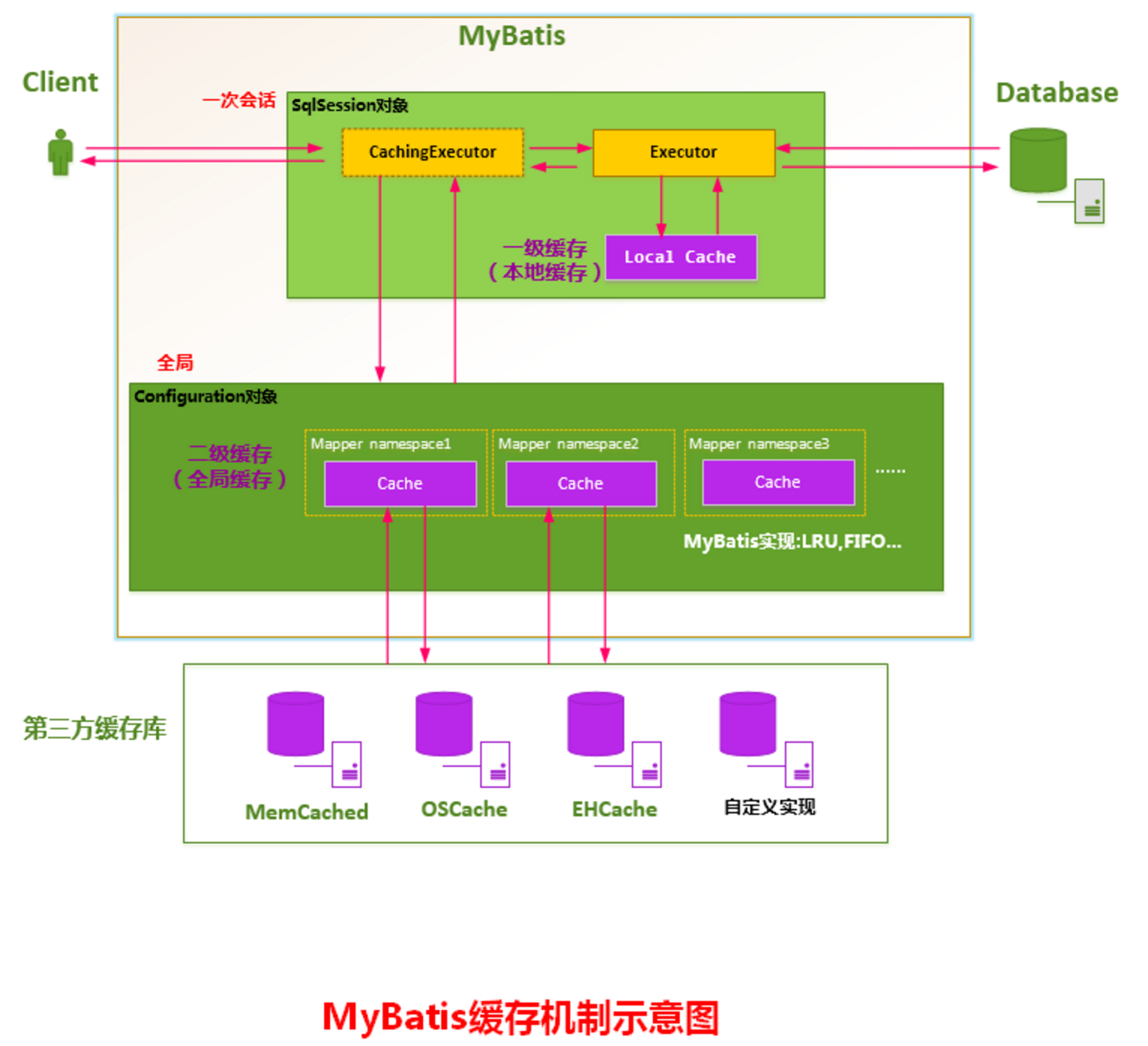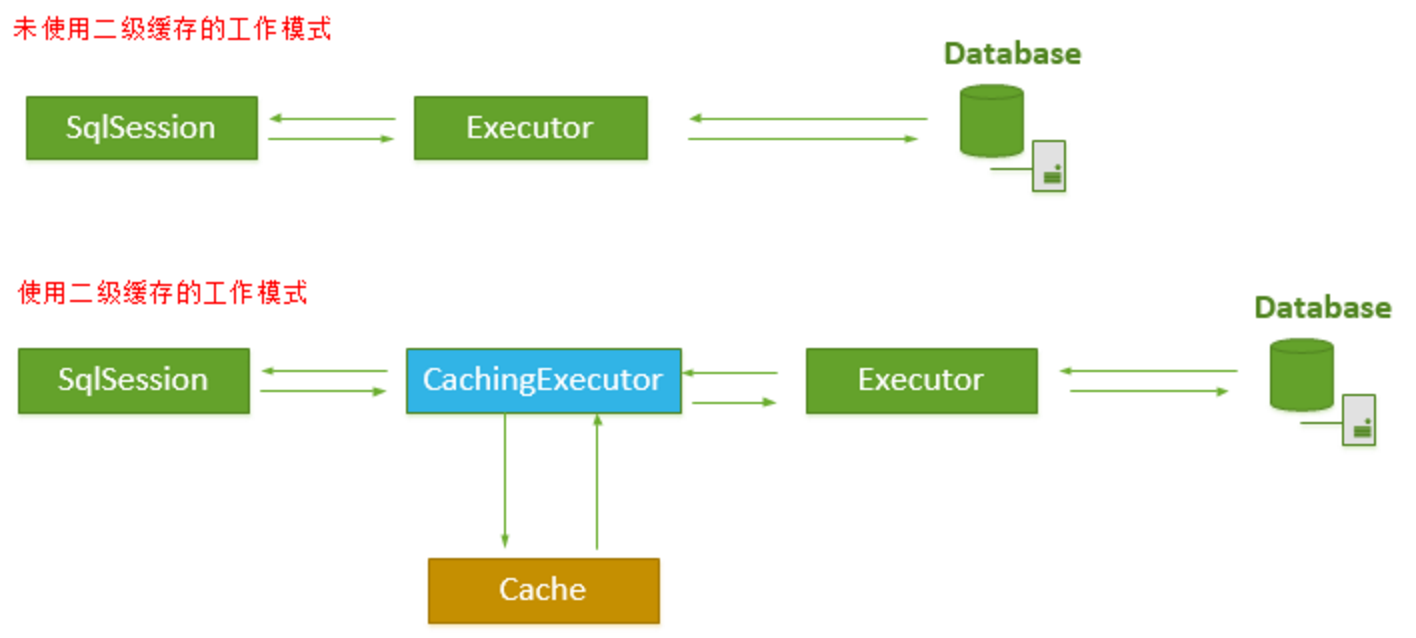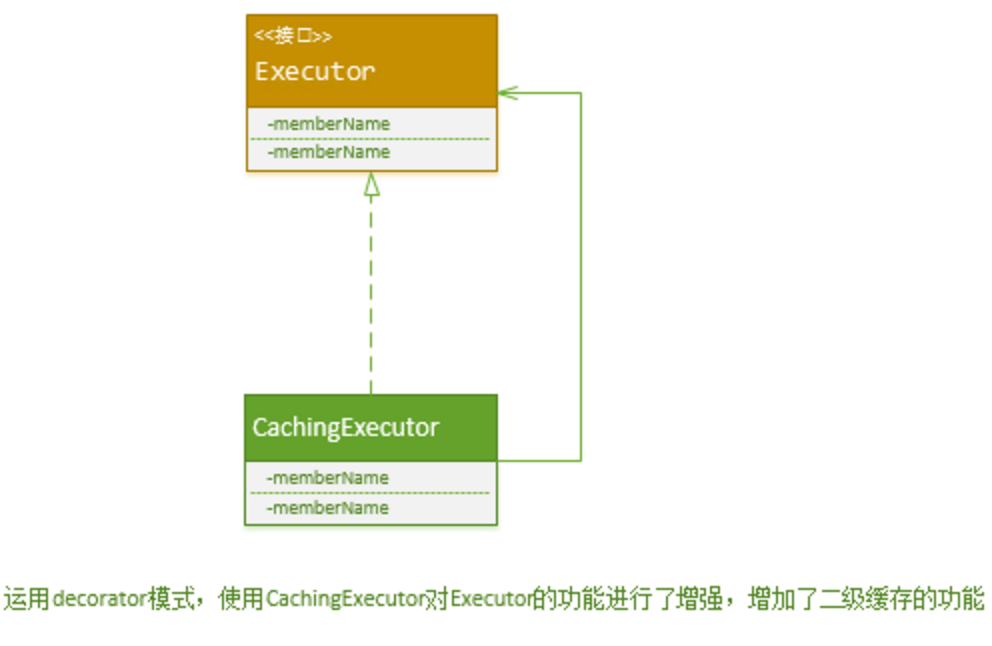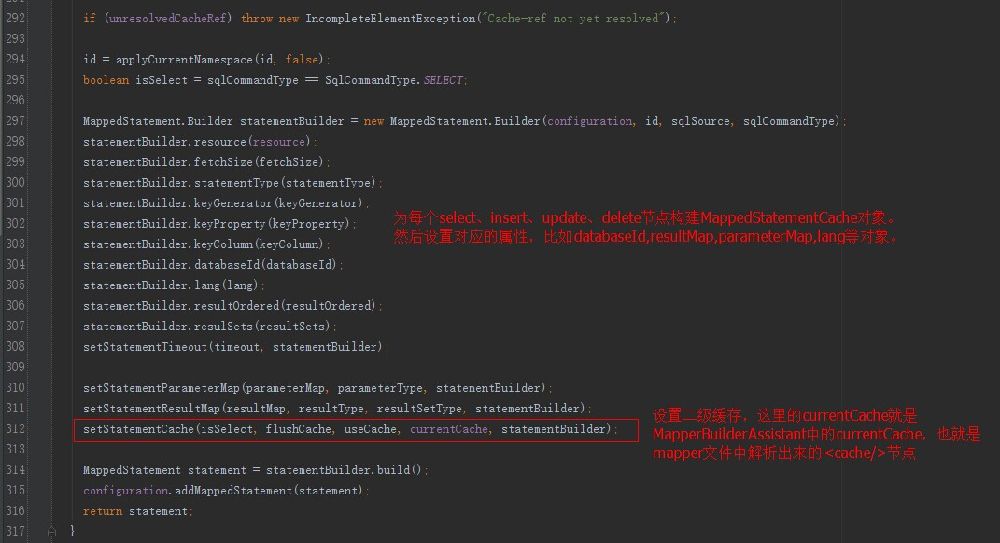1 缓存介绍
MyBatis支持声明式数据缓存(declarative data caching)。当一条SQL语句被标记为“可缓存”后,首次执行它时从数据库获取的所有数据会被存储在一段高速缓存中,今后执行这条语句时就会从高速缓存中读取结果,而不是再次命中数据库。MyBatis提供了默认下基于Java HashMap的缓存实现,以及用于与OSCache、Ehcache、Hazelcast和Memcached连接的默认连接器。MyBatis还提供API供其他缓存实现使用。
重点的那句话就是:MyBatis执行SQL语句之后,这条语句就是被缓存,以后再执行这条语句的时候,会直接从缓存中拿结果,而不是再次执行SQL。
这也就是大家常说的MyBatis一级缓存,一级缓存的作用域scope是SqlSession。MyBatis同时还提供了一种全局作用域global scope的缓存,这也叫做二级缓存,也称作全局缓存。
MyBatis将数据缓存设计成两级结构,分为一级缓存、二级缓存:
一级缓存是Session会话级别的缓存,位于表示一次数据库会话的SqlSession对象之中,又被称之为本地缓存。一级缓存是MyBatis内部实现的一个特性,用户不能配置,默认情况下自动支持的缓存,用户没有定制它的权利(不过这也不是绝对的,可以通过开发插件对它进行修改);
二级缓存是Application应用级别的缓存,它的是生命周期很长,跟Application的声明周期一样,也就是说它的作用范围是整个Application应用。
MyBatis中一级缓存和二级缓存的组织如下图所示:

2 一级缓存
一级缓存的工作机制:
一级缓存是Session会话级别的,一般而言,一个SqlSession对象会使用一个Executor对象来完成会话操作,Executor对象会维护一个Cache缓存,以提高查询性能。关于一级缓存的详细实现,可参见MyBatis一级缓存实现。
2.1 缓存测试
同个session进行两次相同查询:
1 |
|
MyBatis只进行1次数据库查询:
1 | ==> Preparing: select * from USERS WHERE ID = ? |
同个session进行两次不同的查询:
1 |
|
MyBatis进行两次数据库查询:
1 | ==> Preparing: select * from USERS WHERE ID = ? |
不同session,进行相同查询:
1 |
|
MyBatis进行了两次数据库查询:
1 | ==> Preparing: select * from USERS WHERE ID = ? |
同个session,查询之后更新数据,再次查询相同的语句:
1 |
|
更新操作之后缓存会被清除:
1 | ==> Preparing: select * from USERS WHERE ID = ? |
很明显,结果验证了一级缓存的概念,在同个SqlSession中,查询语句相同的sql会被缓存,但是一旦执行新增或更新或删除操作,缓存就会被清除。
2.2 源码分析
在分析MyBatis的一级缓存之前,我们先简单看下MyBatis中几个重要的类和接口:
org.apache.ibatis.session.Configuration类:MyBatis全局配置信息类
org.apache.ibatis.session.SqlSessionFactory接口:操作SqlSession的工厂接口,具体的实现类是DefaultSqlSessionFactory
org.apache.ibatis.session.SqlSession接口:执行sql,管理事务的接口,具体的实现类是DefaultSqlSession
org.apache.ibatis.executor.Executor接口:sql执行器,SqlSession执行sql最终是通过该接口实现的,常用的实现类有SimpleExecutor和CachingExecutor,这些实现类都使用了装饰者设计模式
一级缓存的作用域是SqlSession,那么我们就先看一下SqlSession的select过程:
- 这是DefaultSqlSession(SqlSession接口实现类,MyBatis默认使用这个类)的selectList源码(我们例子上使用的是selectOne方法,调用selectOne方法最终会执行selectList方法):
1 | public <E> List<E> selectList(String statement, Object parameter, RowBounds rowBounds) { |
- 我们看到SqlSession最终会调用Executor接口的方法。接下来我们看下DefaultSqlSession中的executor接口属性具体是哪个实现类。DefaultSqlSession的构造过程(DefaultSqlSessionFactory内部):
1 | private SqlSession openSessionFromDataSource(ExecutorType execType, TransactionIsolationLevel level, boolean autoCommit) { |
- 我们看到DefaultSqlSessionFactory构造DefaultSqlSession的时候,Executor接口的实现类是由Configuration构造的:
1 | public Executor newExecutor(Transaction transaction, ExecutorType executorType, boolean autoCommit) { |
Executor根据ExecutorType的不同而创建,最常用的是SimpleExecutor,本文的例子也是创建这个实现类。 最后我们发现如果cacheEnabled这个属性为true的话,那么executor会被包一层装饰器,这个装饰器是 CachingExecutor。其中cacheEnabled这个属性是mybatis总配置文件中settings节点中cacheEnabled子节点的值,默认就是true,也就是说我们在mybatis总配置文件中不配cacheEnabled的话,它也是默认为打开的。
- 现在,问题就剩下一个了,CachingExecutor执行sql的时候到底做了什么?带着这个问题,我们继续走下去(CachingExecutor的query方法):
1 | public <E> List<E> query(MappedStatement ms, Object parameterObject, RowBounds rowBounds, ResultHandler resultHandler, CacheKey key, BoundSql boundSql) throws SQLException { |
其中Cache cache = ms.getCache();这句代码中,这个cache实际上就是个二级缓存,由于我们没有开启二级缓存(二级缓存的内容下面会分析),因此这里执行了最后一句话。这里的delegate也就是SimpleExecutor,SimpleExecutor没有Override父类的query方法,因此最终执行了SimpleExecutor的父类BaseExecutor的query方法。
- 所以一级缓存最重要的代码就是BaseExecutor的query方法!
1 | public <E> List<E> query(MappedStatement ms, Object parameter, RowBounds rowBounds, ResultHandler resultHandler, CacheKey key, BoundSql boundSql) throws SQLException { |
BaseExecutor的属性localCache是个PerpetualCache类型的实例,PerpetualCache 类是实现了MyBatis的Cache缓存接口的实现类之一,内部有个Map 类型的属性用来存储缓存数据。 这个localCache的类型在BaseExecutor内部是写死的。 这个localCache就是一级缓存!
- 接下来我们看下为何执行新增或更新或删除操作,一级缓存就会被清除这个问题。首先MyBatis处理新增或删除的时候,最终都是调用update方法,也就是说新增或者删除操作在MyBatis眼里都是一个更新操作。我们看下DefaultSqlSession的update方法:
1 | public int update(String statement, Object parameter) { |
很明显,这里调用了CachingExecutor的update方法:
1 | public int update(MappedStatement ms, Object parameterObject) throws SQLException { |
这里的flushCacheIfRequired方法清除的是二级缓存,我们之后会分析。 CachingExecutor委托给了(之前已经分析过)SimpleExecutor的update方法,SimpleExecutor没有 Override父类BaseExecutor的update方法,因此我们看BaseExecutor的update方法:
1 | public int update(MappedStatement ms, Object parameter) throws SQLException { |
- 我们看到了关键的一句代码: clearLocalCache(); 进去看看:
1 | public void clearLocalCache() { |
没错,就是这条,sqlsession没有关闭的话,进行新增、删除、修改操作的话就是清除一级缓存,也就是SqlSession的缓存。
3 二级缓存
二级缓存的作用域是全局,换句话说,二级缓存已经脱离SqlSession的控制了。二级缓存的作用域是全局的,二级缓存在SqlSession关闭或提交之后才会生效。
在分析MyBatis的二级缓存之前,我们先简单看下MyBatis中一个关于二级缓存的类(其他相关的类和接口之前已经分析过):
org.apache.ibatis.mapping.MappedStatement:
MappedStatement类在Mybatis框架中用于表示XML文件中一个sql语句节点,即一个
二级缓存的工作机制:
一个SqlSession对象会使用一个Executor对象来完成会话操作,MyBatis的二级缓存机制的关键就是对这个Executor对象做文章。如果用户配置了”cacheEnabled=true”,那么MyBatis在为SqlSession对象创建Executor对象时,会对Executor对象加上一个装饰者:CachingExecutor,这时SqlSession使用CachingExecutor对象来完成操作请求。CachingExecutor对于查询请求,会先判断该查询请求在Application级别的二级缓存中是否有缓存结果,如果有查询结果,则直接返回缓存结果;如果缓存中没有,再交给真正的Executor对象来完成查询操作,之后CachingExecutor会将真正Executor返回的查询结果放置到缓存中,然后在返回给用户。
MyBatis的二级缓存设计得比较灵活,你可以使用MyBatis自己定义的二级缓存实现;你也可以通过实现org.apache.ibatis.cache.Cache接口自定义缓存;也可以使用第三方内存缓存库,如Memcached等。


3.1 缓存配置
二级缓存跟一级缓存不同,一级缓存不需要配置任何东西,且默认打开。 二级缓存就需要配置一些东西。本文就说下最简单的配置,在mapper文件上加上这句配置即可。其实二级缓存跟3个配置有关:
- mybatis全局配置文件中的setting中的cacheEnabled需要为true(默认为true,不设置也行)
- mapper配置文件中需要加入
节点 - mapper配置文件中的select节点需要加上属性useCache需要为true(默认为true,不设置也行)
3.2 缓存测试
不同SqlSession,查询相同语句,第一次查询之后commit SqlSession:
1 |
|
MyBatis仅进行了一次数据库查询:
1 | ==> Preparing: select * from USERS WHERE ID = ? |
不同SqlSession,查询相同语句,第一次查询之后close SqlSession:
1 |
|
MyBatis仅进行了一次数据库查询:
1 | ==> Preparing: select * from USERS WHERE ID = ? |
不同SqlSesson,查询相同语句。 第一次查询之后SqlSession不提交:
1 |
|
MyBatis执行了两次数据库查询:
1 | ==> Preparing: select * from USERS WHERE ID = ? |
3.3 源码分析
- XMLMappedBuilder(解析每个mapper配置文件的解析类,每一个mapper配置都会实例化一个XMLMapperBuilder类)的解析方法:
1 | private void configurationElement(XNode context) { |
- 我们看到了解析cache的那段代码:
1 | private void cacheElement(XNode context) throws Exception { |
- 解析完cache标签之后会
使用builderAssistant的userNewCache方法,这里的builderAssistant是一个MapperBuilderAssistant类型的帮助类,每个XMLMappedBuilder构造的时候都会实例化这个属性,MapperBuilderAssistant类内部有个Cache类型的currentCache属性,这个属性也就是mapper配置文件中 cache节点所代表的值:
1 | public Cache useNewCache(Class<? extends Cache> typeClass, |
OK,现在mapper配置文件中的cache节点被解析到了XMLMapperBuilder实例中的builderAssistant属性中的currentCache值里。
- 接下来XMLMapperBuilder会解析select节点,解析select节点的时候使用XMLStatementBuilder进行解析(也包括其他insert,update,delete节点):
1 | public void parseStatementNode() { |
这段代码前面都是解析一些标签的属性,我们看到了最后一行使用builderAssistant添加MappedStatement,其中builderAssistant属性是构造XMLStatementBuilder的时候通过XMLMappedBuilder传入的,我们继续看builderAssistant的addMappedStatement方法:

- 进入setStatementCache:
1 | private void setStatementCache( |
最终mapper配置文件中的遍历CRUD节点的时候将这个cache节点设置到这些CRUD节点中,这个cache就是所谓的二级缓存!
- 接下来我们回过头来看查询的源码,CachingExecutor的query方法:
1 | public <E> List<E> query(MappedStatement ms, Object parameterObject, RowBounds rowBounds, ResultHandler resultHandler, CacheKey key, BoundSql boundSql) |
- 进入TransactionalCacheManager的putObject方法:
1 | public void putObject(Cache cache, CacheKey key, Object value) { |
- TransactionalCache的putObject方法:
1 | public void putObject(Object key, Object object) { |
我们看到,数据被加入到了entriesToAddOnCommit中,这个entriesToAddOnCommit是什么东西呢,它是TransactionalCache的一个Map属性:
1 | private Map<Object, AddEntry> entriesToAddOnCommit; |
AddEntry是TransactionalCache内部的一个类:
1 | private static class AddEntry { |
好了,现在我们发现使用二级缓存之后:查询数据的话,先从二级缓存中拿数据,如果没有的话,去一级缓存中拿,一级缓存也没有的话再查询数据库。有了数据之后在丢到TransactionalCache这个对象的entriesToAddOnCommit属性中。
接下来我们来验证为什么SqlSession commit或close之后,二级缓存才会生效这个问题。
- DefaultSqlSession的commit方法:
1 | public void commit(boolean force) { |
- CachingExecutor的commit方法:
1 | public void commit(boolean required) throws SQLException { |
- tcm.commit即 TransactionalCacheManager的commit方法:
1 | public void commit() { |
- TransactionalCache的commit方法:
1 | public void commit() { |
- 发现调用了AddEntry的commit方法:
1 | public void commit() { |
发现了! AddEntry的commit方法会把数据丢到cache中,也就是丢到二级缓存中!
关于为何调用close方法后,二级缓存才会生效,因为close方法内部会调用commit方法。本文就不具体说了。 读者有兴趣的话看一看源码就知道为什么了。
4 Cache接口
org.apache.ibatis.cache.Cache是MyBatis的缓存接口,想要实现自定义的缓存需要实现这个接口。MyBatis中关于Cache接口的实现类也使用了装饰者设计模式。我们看下它的一些实现类:

简单说明:
LRU – 最近最少使用的:移除最长时间不被使用的对象。
FIFO – 先进先出:按对象进入缓存的顺序来移除它们。
SOFT – 软引用:移除基于垃圾回收器状态和软引用规则的对象。
WEAK – 弱引用:更积极地移除基于垃圾收集器状态和弱引用规则的对象。
1 | <cache |
cache-ref节点:mapper配置文件中还可以加入cache-ref节点,它有个属性namespace。如果每个mapper文件都是用cache-ref,且namespace都一样,那么就代表着真正意义上的全局缓存。如果只用了cache节点,那仅代表这个这个mapper内部的查询被缓存了,其他mapper文件的不起作用,这并不是所谓的全局缓存。
